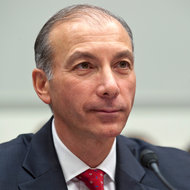GE CAPITAL this week is embarking on an elaborate advertising campaign with Slate.com featuring a six-month roadshow across the United States meant to stimulate its lending to midsize businesses.
According to research done by the National Center for the Middle Market at Ohio State University, businesses with revenue of $10 million to $1 billion account for more than 43 million jobs in the United States and one-third of the national private sector gross domestic product. GE Capital underwrites the center, founded in 2011. Steven Winoker, who follows General Electric for Sanford C. Bernstein Company, called lending to middle-market businesses a “profitable business and a core business” for GE Capital, adding that it was “probably better at originating this kind of business than its competitors because of its industrial heritage.”
According to Mr. Winoker, GE Capital generated 47 percent of total earnings for General Electric last year, up from 28 percent in 2009; he also said commercial lending and leasing — a large part of which is to midsize businesses — was responsible for about a third of GE Capital’s profit last year.
Mr. Winoker said G.E. generally had a “more advanced view of advertising and marketing and is more aggressive in its approach to marketing than most industrial companies, from its heritage of owning” NBC Universal, whose sale to Comcast was completed last year.
Nicholas P. Heymann, who follows G.E. for William Blair Company, said that one factor behind the campaign might be possible changes in banking regulations resulting from the Dodd-Frank law’s stress test for 2013 that could limit major banks’ ability to lend to smaller businesses.
“Some of GE Capital’s highest returns on investment come from its middle-market lending portfolio,” he said. “If there are changes from a regulatory standpoint, GE Capital wants to be optimally positioned to take advantage of any void that may be created from restricted money center bank lending.”
The campaign — which began Monday in Kansas City, Mo., and is considered native advertising, or content sponsored by advertisers — is the most elaborate initiative created by SlateCustom, the custom-publishing arm of Slate.com, the online magazine. Previous native advertising on Slate.com included a campaign by the Dairy Council, which looked at the impact of last year’s drought on dairy farmers, and distribution of a video promoting Coca-Cola’s anti-obesity campaign.
Ian Forrest, vice president of global marketing at GE Capital, said his company had run traditional banner advertising on Slate.com for the last two years. “The performance worked really well against our core target audience — middle-market, C-level executives,” he said.
He also said the new roadshow, a collaboration jointly developed by GE Capital and Slate.com, was aimed at providing a “holistic, 360-degree view of the middle-market opportunity,” and also to “touch customers, prospective customers, employees and policy makers, to start a dialogue and discussion.” Another goal, he added, is to motivate legislators to pass new regulations in support of middle-market business growth.
“The Roadshow for Growth” entails a bus tour through various cities across the United States. After Kansas City, it moves on to St. Louis, Indianapolis, Chicago, Detroit, Cleveland, Pittsburgh, New York, Dallas, Atlanta and Los Angeles, among others. It will end in Columbus, Ohio, in late October.
At each stop, the roadshow will host different events, like town hall discussions, conversations with the city’s mayor, and visits with middle-market businesses. In Kansas City on Monday, for example, there was a meeting with Mayor Sly James and a town hall session with GE Capital employees, while the Chicago visit on Thursday is to include a discussion moderated by Jacob Weisberg, chairman of the Slate Group, and featuring Mayor Rahm Emanuel and economist Austan Goolsbee, chairman of the Council of Economic Advisers during the first term of the Obama administration.
Daily blog posts, video and commentary on the roadshow will be published on a special Web site, roadshow.slate.com. The Web site is being promoted as a “sponsored section” on slate.com.
Lindsay Nelson, vice president of integrated programs for Slate.com, said her company had gone to “great lengths” to make it clear to readers that the roadshow’s online section was “a special section brought to you by GE Capital, SlateCustom, National Center for the Middle Market,” via a note on the site and a separate pop-up message.
This disclaimer is no doubt meant to avoid controversy like that generated in January when The Atlantic ran a story on its Web site about the Church of Scientology that resembled its regular content, though it was labeled “sponsored content.”
Mr. Forrest said GE Capital would promote the roadshow on Slate.com, various G.E. Web sites, and through digital advertising on Web sites of Yahoo Finance and Bloomberg. He said the total budget for the roadshow would be between $1.5 million and $2 million.
According to Kantar Media, GE Capital’s advertising expenditures in the last five years ranged from a low of $4.3 million in 2008 to a high of $58 million in 2010; last year’s spending was $9.3 million, almost $2 million of which was for Internet display advertising.
Loren Ghiglione, a professor at Northwestern University’s Medill School of Journalism, said the collaboration between Slate.com and GE Capital raised the question of “what it will do to the reputation of Slate.”
The program’s aim to motivate legislators to pass new regulations supporting middle-market businesses “sounds like lobbying to me. I don’t think that journalism and lobbying are the same thing,” he said.
Sharmila C. Chatterjee, a senior lecturer at the M.I.T. Sloan School of Management who studies business-to-business marketing, called the roadshow a “very nice way for GE Capital to connect with customers, establish credibility and gain their trust, three very important things in the day of information bombardment.”
She warned, though, that if the initiative was “hijacked by interest groups and gets politicized, the goal will not be fulfilled.”
Article source: http://www.nytimes.com/2013/05/08/business/media/ge-capital-puts-on-a-lending-roadshow.html?partner=rss&emc=rss


